- Volume 46 | Permalink
- Print article
- Download PDF 1.5mb
Abstract
This essay examines the iconographic and compositional context in which the images of donors appear in stone stelae prepared in the ninth through the twelfth century, the heyday of Indian Esoteric (Tantric) Buddhism. When read together with the accompanying inscriptions, the manner in which human donor figures are represented reiterates a maṇḍalaic, hierarchical worldview and reinforces established social relations of the lived world. Taking the observation of behaviors carved on stone as a starting point for understanding performative aspects of otherwise motionless sculptures, this study suggests that specific design strategies seen in elaboration of decorative and architectural framing devices in late Buddhist images helped shape the vision practices of Indian Esoteric Buddhism described in many sādhana (lit. conjuring up a deity, adoration) texts.
Prologue: Looking for Action in Stone
What are we supposed to do when we visit a temple? How do we know what to do and how to behave? When I took a small group of college students to Wat Nawamintararachutis, a newly built Thai Buddhist temple in Raynham, Massachusetts,[1] on a Saturday morning in early October, I asked them to observe what other people were doing in the temple and to think about a pattern of behavior demanded by the space. I also intended the experience to be an immersion, to help the students understand the devotional context of the Buddhist statues, other religious objects, and architectural fragments that they had seen in the South and Southeast Asian art gallery at the Museum of Fine Arts, Boston.
The temple was established to honor His Majesty King Rama IX of Thailand (King Bhumibol Adulyadej the Great), who was born in Cambridge, Massachusetts, and to serve as a Thai American cultural center addressing the needs of the Thai Buddhist community in New England.[2] Unlike a Hindu temple that we visited a few weeks after this trip—where multiple pūjās were simultaneously conducted by groups of priests with throngs of visitors and devotees, including the elaborate bathing and ornamenting ceremony of Śrī Venkanṭeśvara (Sri Venkateswara abhishekam and alamkaram)—the spacious and elegantly built Wat Nawamintararachutis was serene and quiet, with practically no one present but our group.[3] With very few people as a reference point for our own behavior, we were guided mostly by signboards, such as the one instructing visitors to remove their shoes before entering the meditation hall on the second floor or the temple on the third floor, and by how the space was designed and programed. For example, the third-floor temple is a grand hall with a high, ornately glittery ceiling and shiny marble tiled floor. The vast open space made it challenging to read how to proceed in the space, but our attention was immediately drawn to the raised platform at the end of the hall, which had a majestic arrangement of five gilded statues and various offerings.
As seen in figure 1, the central Buddha is seated on a tall, mountain-like pedestal, displaying the familiar gesture of earth touching (signaling the moment of his enlightenment), done in the Sukhothai style with the characteristic soaring flame above his uṣṇīṣa, perfectly arched, bow-like eyebrows, aquiline nose, tubular limbs, and elongated fingers. He is flanked by two much smaller standing images of the Buddha. Toward the front of the platform, two more statues are on either corner: almost identical figures of monks kneel down at the bottom of the Buddha’s seat with their heels propped up and toes flexed, holding their hands folded together in front of their chests in the gesture of reverence and salutation (añjali mudrā) (fig. 2). At larger than life-size, the two monks kneeling down on the front of this magnificent altar may be there to signal the monastic lineage going back to the Buddha’s foremost disciples.[4] With their backs to us, their placement and reverent postures suggest an appropriate behavior in the space. While an outsider may not necessarily imitate the gesture, the statues’ presence would compel any contemporary visitor to be respectful and sincere.


When a family of Thai Buddhist visitors arrived on the day of our visit, they gathered in front of the altar and paid respect by kneeling down in the exact same manner as the images of the monks (fig. 3). The only difference was that the lay devotees lowered their heads much deeper and raised their folded hands higher. The kneeling male lay devotee (the father of the family) and the statue of a kneeling monk in prayer were in perfect harmony, and together they intensified the devotional sincerity that the space was designed to demand.[5]
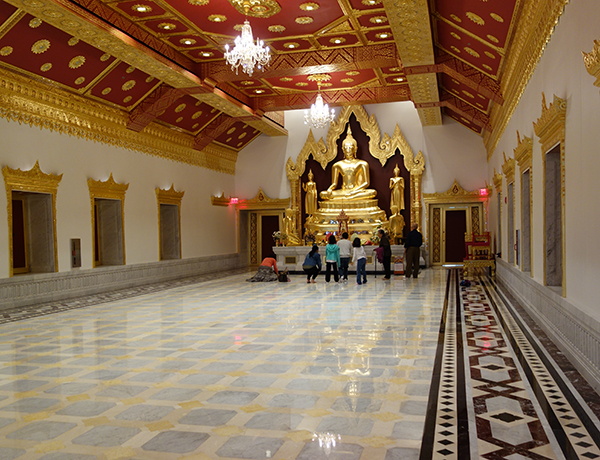
I start this essay with a visit to a twenty-first-century Thai Buddhist temple in New England because this scene—a family of devotees kneeling under a spectacular presentation of the images of the Buddha and monks—resonates greatly with the main topic of this study: the representation of miniature human figures in Buddhist art of Eastern India and their raîson d’être and relationship to the production and use of images in late Indic Buddhist context. While completely anachronistic, this vignette from a contemporary diasporic community temple helps us imagine immediate physical and ritual context that many Buddhist images from India sorely lack.
Buddhist stone sculptures from eastern Indian Buddhist sites are completely dispersed from their original contexts, due in part to the ravages of time and climate and subsequent human activities. Many archaeological sites disintegrated beyond recognition before more scientific documentation was possible. As scholars like Frederick Asher and Janice Leoshko ably demonstrated,[6] the sculptures’ utter dispersal is also due to the practice of collecting Buddhist art that began during British rule in India.[7] A number of prominent Buddhist sites in Bihar and Bengal have been known for centuries, and some of them have seen multiple excavation seasons. The existence of excavated and conserved pilgrimage and monastic sites in Bihar and Bengal (the Gangetic plain and delta), especially in the areas around ancient Magadha, the de facto heartland of Buddhism, would seem to raise our chance to understand physical and ritual contexts of images from these places. However, for a variety of reasons, it does not help with our understanding of physical and ritual context of the images that are now housed in various museums across the globe. Nonetheless, I insist on probing the issue of context from various vantage points, taking the sculptures’ formal qualities as an especially important entry point to considering what these images do and how they do it.
Reading iconography (i.e., figuring out which diverse form of a divinity an image represents) is certainly one way to understand a Buddhist image. Identifying the particular form of bodhisattva Avalokiteśvara represented in a stone stele now in the National Museum of Bangladesh in Dhaka (fig. 4) is an important exercise. We identify this image as Khasarpaṇa Lokeśvara by looking at the specifics of the iconographic features in the center of the stele. The beautifully adorned bodhisattva seated in ardhaparyaṅka posture (with one leg down) and holding a padma (fully blown lotus) in his broken left hand is Avalokiteśvara. He is accompanied by four attendants, two goddesses, and two male figures. The goddesses stand on either side of the bodhisattva: Tārā, holding an utpala, the “blue” night lotus represented by a triangular shape, and Bhṛkuṭī, four-armed with a stūpa on her headdress, her upper right hand in the gesture of greeting, and holding a mālā (prayer beads) and kuṇḍī (long-necked water vessel). The male figures are seated beside Avalokiteśvara: a slender figure kneeling respectfully in añjali mudrā is Sudhāna, and a chubby figure with rising hair and wide-open eyes, holding the gesture of threatening (tarjanī mudrā) and a club, is Hayagrīva. This particular assemblage of Avalokiteśvara’s retinue appears under a tri-lobed arch upper structure, on which a wondrous mountain landscape unfolds, with birds and monkeys frolicking about. The landscape depicts Mt. Potalaka, in which Khasarpaṇa is envisioned to reside, according to a sādhana (lit. propitiation, conjuring up; an instruction of method for identifying with a chosen deity through ritual means) attributed to one Padmākaramati.[8] In fact, the identification of this stele and those that have similar iconographic compositions as Khasarpaṇa comes from reading the descriptions given in the sādhana texts collected in various compilations.[9]
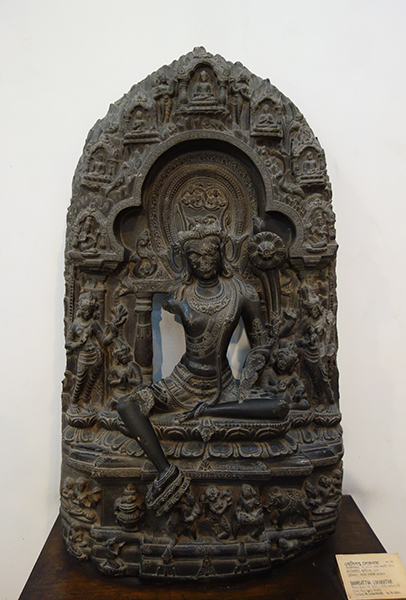
Looking for textual sources to match the visual data is a typical method used in the study of Buddhist iconography. But finding a name by which this form may have been known at the time of production is only a small first step toward understanding such an image.[10] What did this stele of Khasarpaṇa mean to patrons and viewers when it was made? What was the context of this image? Today, it is a masterpiece displayed in the national museum’s pre-Islamic art gallery, among many stone sculptures of Bengal, as a fine specimen of medieval sculptures of Bangladesh, praised for its beauty. Did people in the early eleventh century in the area around the ancient city of Vikramapura (Dhaka district) recognize and appreciate its beauty? What kind of emotions and actions did this image evoke a millennium ago?
Most of these questions are almost impossible to answer with certainty. Yet, I believe we can find more clues when we broaden our field of vision and read associated texts with phenomenological questions in mind. By a broader field of vision, I mean shifting our attention to the periphery of the composition, where actions of the human world happen. Following the insightful observation made by Claudine Bautze-Picron more than two decades ago, I emphasize the importance of this zone, often situated on the bottom part of a stele, for understanding the meaning of images in the context of late Indian Buddhist art.[11] In considering the affects of the images, I am also helped by Janice Leoshko, who, by looking closely at a group of images, successfully argues for the efficacy of a specific type of image (the Buddha in bhūmisparśa mudrā) in the heartland of Buddhism from the sixth through the twelfth century.[12]
The miniature human figures are represented as engaged in devotional activities of offering garlands and flowers or paying homage in añjalī mudrā, and they certainly portray devotees. In some eastern Indian examples, inscriptions label the human figures with their names, supporting their characterization as images of historical donors and their relations.[13] Whether these human figures all represent the donors of the images is still debatable. My emphasis is more on the reality of these images—in other words, as vignettes of the lived reality.
I use the term “donor” partly because this allows me to identify many unnamed human figures by name in inscribed examples. The specificity helps me to conceptualize a more concrete, localized historical narrative. In addition, using “donor” as an analytical category is conducive to discussing the socioeconomic environment of image making and use in medieval South Asia. Economic transactions involved in image making at religious sites in ancient and medieval South Asia are difficult to reconstruct from existing evidence. We get a glimpse of this aspect in medieval Jain texts analyzed and translated by Phyllis Granoff that discuss proper payments for artisans hired for constructing a temple as a religious donation, which also involved image making.[14] Although the texts Granoff discusses date to the thirteenth century or later and belong to a non-Buddhist context, given the practical nature of most śilpaśāstra and nibandha texts, the emphasis on paying a proper price (mūlya) to the artists (or even on overpaying) and establishing a good relationship with them to secure a desirable outcome is worth noting when we consider the socioeconomic values of image donations. The general correlation between a patron’s material resources and the quality of artistic outcome observable in medieval temple construction seems to hold true in sculptural production at a more local, non-royal level.[15]
Beyond acknowledging the agency of human figures by incorporating inscriptional evidence, I propose to analyze the types of actions represented in these scenes of the human world and consider the meanings generated and reinforced by specific configurations. I suggest that the way in which multiple human figures are represented in relation to each other reinforces established social relations of the lived world, while the manner in which human figures are represented vis-à-vis the representations of the divine world reiterates a maṇḍalaic, hierarchical worldview that was established in the social context of early medieval India (the so-called “samanta feudalism”).[16]
I also consider specific design strategies seen in the elaboration of decorative and architectural framing devices in late Buddhist images as actively shaping the vision practices of Indian Esoteric Buddhism. The human activities represented on the Buddhist images dateable to about ca. 1000 CE onward are focused on devotional activities similar to those observed in the earlier images, i.e., offering of garlands and paying homage in añjalī mudrā.[17] While images may not have been an optical focus of a vision practice, an image’s compositional structure most likely helped condition how a practitioner was to see the image of the divine that s/he was to identify with through various ritual means, including “seeing” a deity as explained in many sādhana texts. Most sādhana texts frame “seeing” the divine world within the context of manifold ritual actions, and “seeing” is the verb for an at times dizzying movement of a mental image that is to be conjectured.[18]
As I have demonstrated elsewhere, given the diverse and at times local nature of sādhanas collected in literature such as the Sādhanasamuccaya, the Sādhanasagara, and the Sādhanaśatapañcāśika, compiled in the eleventh century or later, it is quite likely that artistic inputs seen in surviving images helped shape the forms of the deities as articulated in these texts.[19] By looking carefully and appreciating subtle differences and similarities of form, I believe we can begin to unpack the performative potential of Buddhist images as active agents in shaping and conditioning the way of seeing at local and personal levels. We also can find a way to discuss the art of late Indian Buddhism beyond the prescriptive language of Esoteric Buddhist ritual practices.
Scope of the Study
Hundreds of stone sculptures with small human figures in their compositions survive from Bihar and Bengal and are now dispersed around the globe.[20] A systematic survey and study of these figures and the accompanying inscriptions would help us understand the sociocultural context of the production of stone sculptures in early medieval eastern India (here referring to the area comprising Bihar, West Bengal, and Odisha in India and Bangladesh). While I eagerly await such a study, I have a more modest goal in this paper. I present a couple of examples as case studies to underscore the importance of close looking, a fundamental art historical tool, for understanding aspects of performance in Buddhist art, which are often explored through sources external to the images.
In considering the performativity of the images, I also consider the accompanying inscriptions as an important part of the visual field.[21] As scholars like Gregory Schopen and Jason McCombs demonstrate, the practice of inscribing the Mahāyāna donative formula that proclaims the merits (puṇya) accrued from the giving (of the image) for all sentient beings seems to have been established in the post-sixth-century context.[22] The frequent pairing of the donor inscription with the so-called Buddhist creed or the dharma relic beginning with “ye dharmahetu . . . ,” a verse that epitomizes the Buddhist teaching taken from the Pratītyasamutpādagāthā, puts the inscription and the dharma relic in the same visual plane.[23] The dharma relic functions like a visible seal that activates an image not just as a physical and written trace of a temporary ritual but also as perpetually visual presence of that action. In this vein, the function of the accompanying donor inscription lies not just in relaying information, but also in visually amplifying the declaration of the merits accrued through the donation.
I have chosen examples from two different ancient regions of eastern India, Magadha and Vaṅga. The first group is from established mahāvihāras (grand monastic centers) in the ancient region of Magadha, in today’s Bihar, such as Nālandā and Kurkihar (Āpanaka-mahāvihāra), with comparable earlier examples from another important Buddhist monastic and pilgrimage site, Sarnath, in today’s Uttar Pradesh.[24] Images in this first group belong to the period between the mid-ninth century and the late tenth century. The second set of examples hails from the area around the ancient capital of Vikramapura in today’s Dhaka district, Bangladesh (the ancient region of “Vaṅga”), and they belong to what I categorize as “late Indian Buddhist images” dateable to the eleventh and the twelfth centuries.
Earlier examples from Magadhan monastic centers selected for analysis are monastic donations, while the later examples from Southern Bengal are lay donations.[25] The diversifying nature of Buddhist communities in developing Esoteric Buddhist context complicates this simple distinction between lay and monastic, but in general, the surviving examples seem to bear out the regional and temporal distinctions made in this study.[26] Miniature representations of monastic donors are almost nonexistent in the surviving corpus of late Buddhist images from Bengal.
The social and religious status of Buddhist laity was not monolithic or stagnant. Categorizing people along the monastic line becomes especially problematic for material dating from the beginning of the eleventh century onward, when we start seeing the representation of ritual masters, or ācāryas, along with their lay patrons.[27] By paying close attention to the types of actions represented and exploring the ways in which they are represented, we can make serendipitous yet historically meaningful connections between objects, which offer small vignettes of the moments when images were activated and in use. To this end, I have chosen images that can be related to each other through close looking at a local level. I believe the emerging relationships between images can help us identify a specific local context of production and use of images despite the lack of historical evidence.
My emphasis on local and concrete may limit the applicability of the observations made in this study, but the case studies analyzed here suggest the images’ trajectory. The art historically grounded methodology proposed here should prove useful for future studies of Indian Buddhist art, as it can help contextualize images’ function and meaning.
A Religious Gift
The function and purpose of images made in the context of late Indian Buddhism of the eighth through the twelfth century are often discussed in two different terms: religious donations and visual aids for rituals, particularly sādhana practices. Let us first consider the idea of images as religious gifts. Commissioning an image for religious merit is a common practice in the Indic Buddhist context, as is attested in abundant art historical evidence of freestanding statues and steles found in Buddhist sites dating from the second century onward.[28] The term deyadharma, which means “religious” or “pious” gift, appears frequently on Buddhist sculptures hailing from Bihar and Bengal.[29] A Buddhist donative formula pronouncing that the merits of a religious gift should be the attainment of supreme knowledge by all sentient beings (deyadharmo ’yam . . . yadatra puṇyam tadbhavatu . . . sarvasatvānuttarajñānavāptaye) was finalized during the Gupta period.[30]
Along with the frequent appearance of deyadharma, we notice visual representation of human actors of “real” time—contemporary to when the image was made—rather than of narrative time.[31] Small human figures appearing on the lower part of the famed fifth-century Sarnath stele depicting the first sermon (Archaeological Survey of India Site Museum, Sarnath) may represent the audience of a narrative time (fig. 5). But here, the particularity of a lay female figure kneeling on the far left suggests she may be a person of a historical time: a female donor who commissioned this image (fig. 6). No inscription identifies a donor, but the woman, whose economically and socially privileged identity is borne out by her jewelry and hairdo, is certainly not part of the narrative moment. Unless there was a female donor, it is unlikely that a woman would have been represented as the utmost lay devotee in this superbly carved sculpture of preaching Buddha.
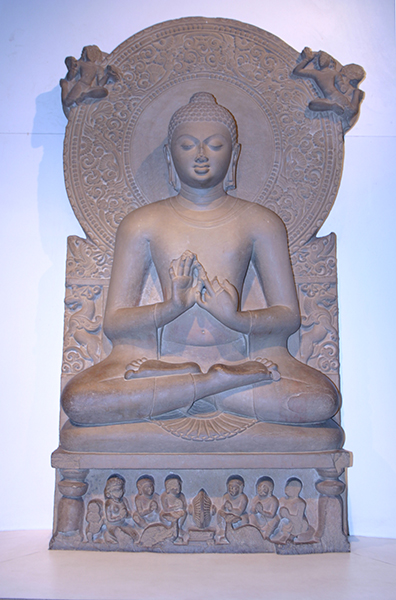
Hierarchical scaling separates the human world on the bottom register from the realm of the Buddha, and the iconographic composition dictated by this hierarchical principle in a way allows the seamless collapsing of real and narrative time. A slightly later (circa 7th century) image of the seated Buddha image in bhūmisparśa mudrā (also in the ASI Site Museum) features a donor inscription prominently carved on the most projected part of the pedestal, which reads, “deyadharmoyam sākyabhikṣu sthavira vandhuguptasya” (this is a religious gift of a monastic elder, Vandhugupta) (fig. 7).
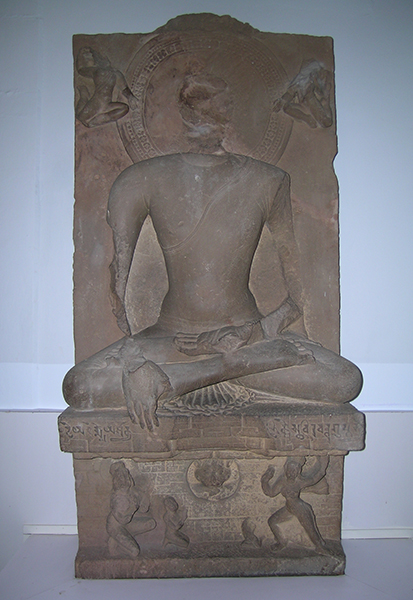
Under this inscribed bar appears an intriguing configuration of images (fig. 8). On the lower left side of the stele is a damaged female figure; she seems to have held an object in her hands, most likely representing the earth goddess with a water vessel. To the right is a striding female figure about to strike a tiny fallen figure, perhaps an early form of the goddess Aparājitā. In front of the earth goddess, toward the center, is a small kneeling male figure in añjalī mudrā. He is depicted at about half the size of the earth goddess, and despite the damage on the face, it is most likely that he represents our monastic donor, Vandhugupta. Although he remains faceless today, we can easily notice that his head is tilted backward: he is in fact looking up the Buddha above the projected seat. The monastic donor is so seamlessly present in the narrative time that it allows him to also be present at the very moment of the Buddha’s enlightenment, which ultimately must have constituted the power of this image for Vandhugupta. It makes the vision of being present at the moment of the Buddha’s enlightenment a part of the lived reality.
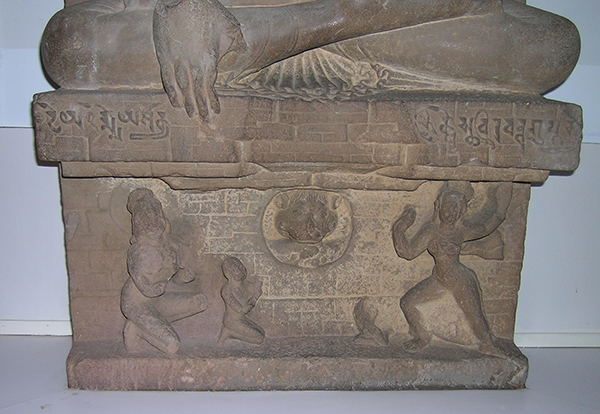
By the eighth century, it seems to have become a common practice to insert little human donor figures in Buddhist image donations, as seen in numerous inscribed examples from Gilgit (especially royal Palola Ṣahī donations).[32] While not every image donation bear a donor’s trace, a donative inscription and a visual representation of a donor became standard affairs. It is on the heels of this long-established tradition that we find small donor figures and donative inscriptions on the bottom registers of steles made in medieval eastern India.
Bautze-Picron in her most recent study of donor images in the Buddhist art of Eastern India suggests that the presence of donor images transforms a religious image into “a place of exchange between two spheres, divine and human” rather than a “fully divine icon” existing outside the social existence of people.[33] While acknowledging the merits of her observation based on an extensive analysis of available material, I would like to dwell on the specificities of forms. In particular, the manner in which these human figures are represented merits further discussion.
Images of Social Hierarchy
Most Buddhist images found in Bihar are associated with monastic centers. A number of images from Magadhan monastic sites are clearly marked as religious donations by monastic persons, often through the accompanying inscriptions. A cursory survey of undated donative inscriptions from Nālandā mahāvihāra, a famous monastic center, suggests that many of the monastic donations were made by senior monks, or sthavira, as in a stele of the standing Buddha image currently installed in the ASI Nālandā Site Museum (fig. 9).[34] The inscription, neatly carved under the standing Buddha in the central projection of the bottom register, announces that it is a “religious gift of the monastic elder, Tathāgatadeva” (deyadharmoyam-stha-tathāgatadevasya). A sthavira title suggests seniority in terms of ordination; according to Peter Skilling, a monk belonging to any of the four main nikāyas becomes a sthavira by completing ten rains-retreats’ ordinations.[35] We may interpret this available data to suggest there may have been a more privileged socioeconomic status of sthavira within the monastic community. A set of images suggests that this seniority may have entailed hierarchical superiority in monastic organization. It is important to note that images visually articulate this hierarchical relationship.
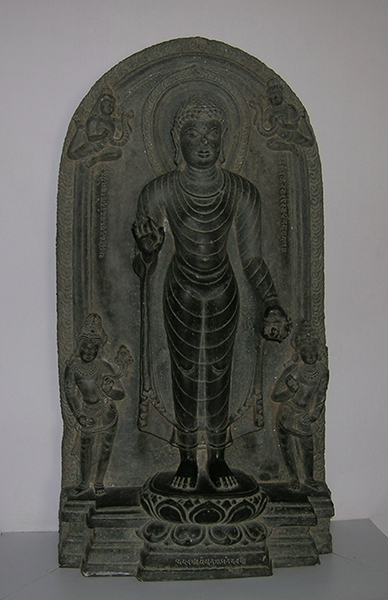
An image of the Buddha Śākyamuni in bhūmisparśa mudrā (earth-touching gesture) now in the Los Angeles County Museum of Art (M 73.4.11) bears an inscription on the central projection (bhadra) of the bottom register that says it is a “religious gift of Vimalaprabha” (deyadharmoyaḥ vimalaprabhasya) (fig. 10). Just above the end of the name, a small human figure sits in front of a pillar of an architectural structure supporting the seat of the Buddha’s enlightenment (fig. 11). This seems to be Vimalaprabha, the donor of the stele. He is depicted in three-quarter profile and seated with his legs half-crossed, holding his hands in prayer in añjalī mudrā. He looks slightly upward, toward the tip of the Buddha’s stretched right hand. Despite the absence of a monastic title like śākyabhikṣu, his simple attire and shaven head with curly hairs that look similar to the Buddha’s suggest his monastic identity. Vimalaprabha is represented as a monastic devotee who perpetually pays homage to the Buddha.
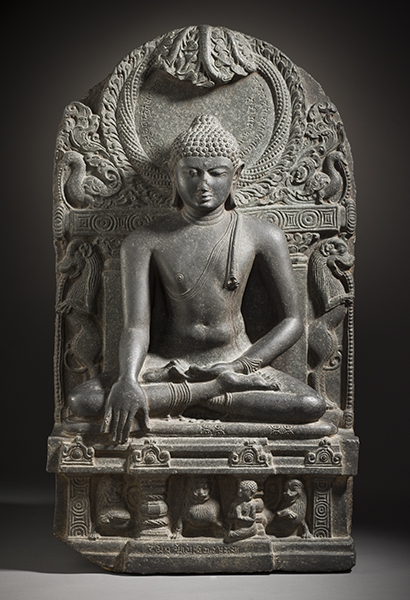
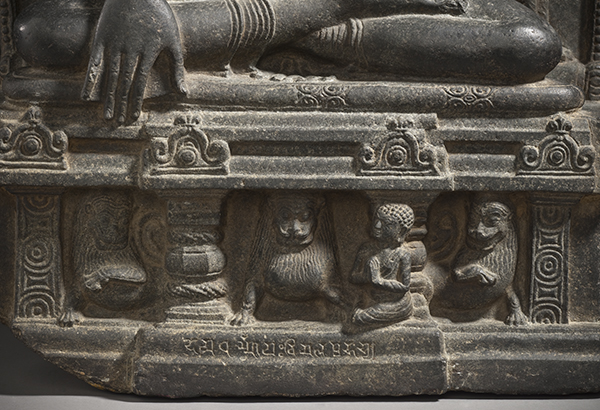
A remarkably similar stele, probably from the same workshop in the vicinity of Gaya in Bihar (i.e., Kurkihar), is now in the Asian Art Museum, San Francisco (B60 S598). The stele also depicts the Buddha Śākyamuni’s enlightenment under the Bodhi tree (fig. 12). The two steles share remarkably similar stylistic features: slightly bulged modeling of the abdomen, broad shoulders with slightly tubular arms, and a square, box-like modeling of the face. They show almost identical treatment of Buddha’s monastic robe and its minimalized pleats. Many secondary formal features are similar as well, as seen in the treatment of the halo and the design of the throne back. Bautze-Picron and Huntington both propose Kurkihar as the site of their production,[36] and Huntington suggests the two may have been “part of a single commission.”[37]
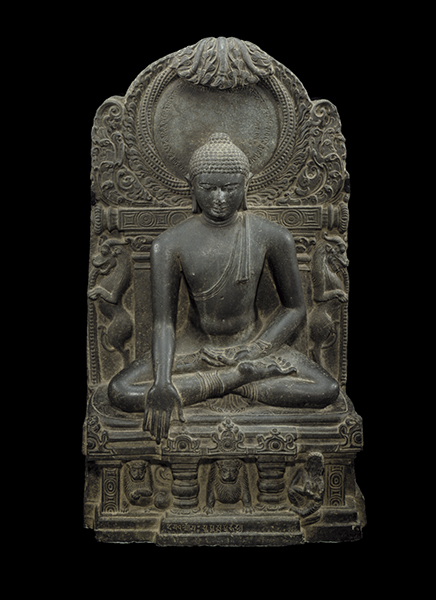
The similarity between the two steles goes beyond stylistic features. In the San Francisco image, we see a neatly carved inscription in the same projected bar on the lowest register of the stele as in the Vimalaprabha’s donation, which reads, “This is a religious gift of a monastic elder, Prajñāprabha” (deyadharmoyaḥ sthaprajñāprabhasya) (fig. 13). Above and to the right of this inscribed register, just outside the central projection with a lion under a two-pillared structure, sits a male figure in añjali mudrā. Although his face has been damaged, this monastic person most likely represents Prajñāprabha. In comparison to Vimalaprabha, he sits in a more casual manner with his right knee raised, and his image juts out. Given their names, both ending in prabha, we may connect them as part of a lineage and even conjecture a teacher-disciple relationship.[38]
When we place the two steles side by side, we see subtle differences between the two that suggest a slightly higher order in the image donated by our senior monk, Prajñāprabha (figs. 10 and 12). Prajñāprabha’s image in San Francisco features an elaborate caitya arch in the center that rises above the lower register’s frame into the seat of the Buddha. This caitya motif in the lower register is absent in Vimalaprabha’s image in Los Angeles.[39] Although the two steles seem to showcase a same level of artistic talents, Prajñāprabha’s image shows a slightly better understanding of how to carve volume, as seen in the modeling of the Buddha’s chest and stretched right hand. Incidentally, the image in San Francisco also is the taller of the two by more than an inch.

Performing Image
Late Indian Buddhist images are not necessarily visual aids or aide-memoirs for visualization practices, despite their close connection with the sādhana texts. I propose that we can better understand the performativity of these images by considering how the images are performed internally and externally, and how these two processes converge on and diverge from the stone steles depicting various deities.
An image of the Buddha signaling enlightenment seems to have been a common choice for a senior monk’s image donation in Magadhan monastic sites during the ninth and the tenth centuries, supporting the previously noted emphasis on the enlightenment experience in late Indian Buddhism.[40] Monastic image donations are not limited to the most doctrinally foundational images, and the monastic donors are often shown engaging in ritual actions rather than simply sitting and paying homage. For example, a circa ninth-century image of Avalokiteśvara from Telhara, a site located about twenty-one miles to the west of Nalanda, now in the Rietberg Museum, Zürich (R-106), has an image of a monk depicted on the viewer’s lower left, under the bodhisattva’s right hand (fig. 15). An inscription directly beneath him identifies his name as “Prajñāseva.” Although there is no monastic title given in front of his name, Prajñāseva’s monastic identity is hard to miss (fig. 16). Seated on a raised stool, holding a burning lamp in his right hand and a bunch of flowers in his left hand, he looks like he is performing aarti (Sanskrit: ārātrika) for an image of Avalokiteśvara.[41] Whether Prajñāseva was a donor of this image is unclear, but the way he commends a ritual and engages the external world by looking forward suggests that the image was meant to be looked at and, most likely, venerated by visitors.[42]
Monks being represented in a position of veneration and devotion in an image that they commissioned does not appear too different from a much earlier practice of donors inserting themselves in their donations to perpetually pronounce the religious merits they accrued through this one action. Images with the donors shown looking up directly the Buddha (or any other Buddhist divinity), as in the seventh-century Sarnath Buddha image with a monk, Vandhugupta, discussed above, do signal a strong emphasis on seeing and being present, which in turn suggests a more interactive and performative function and meaning of stone images as physical presence.[43] A very personal connection between the donor/devotee and the deity established in the image production may in fact relate to the development of a wide variety of Buddhist images in the late Indian Buddhist context, whether we categorize them as Mahāyāna or Esoteric Buddhist (so-called Vajrayāna). Seen from the perspective of the lived reality, it is very possible that images were made from personal visions during this period of incredible iconographic expansion and innovation, which culminated in the compilation of sādhanas in the early twelfth century. Many sādhanas known from the post-eleventh-century compilation record visions of deities as seen and performed by various historical personages, suggesting a historical process in which personal visions were made into a codified system of divine images.[44] I wonder if idiosyncratic iconographic and formal choices noticeable in many Buddhist images of well-known bodhisattvas and goddesses (Avalokiteśvara and Tārā, for example), especially those dateable to between the ninth and the eleventh centuries, may relate to the personal visions of the donors who commissioned them.[45] Let us examine two examples from Nālandā with this possibility in mind.
A circa tenth-century stone stele of Tārā from Nālandā, now in the Indian Museum (A25132), shows a monk on the bottom register engaged in a ritual activity (fig. 16).[46] Standing on a gracefully carved stele is Tārā, a two-armed goddess, with two attendants, most likely Ekajaṭā on our left (a four-armed potbellied female figure holding a stretched elephant skin above her head), and Hayagrīva on our right (a two-armed slender male figure holding a sword and a noose).[47] Tārā has her right hand in varadā mudrā; her left hand holds an utpāla (blue lotus). Two Buddhas displaying two different mudrās, the earth-touching gesture on Tārā’s right (Akṣobhya) and the meditation gesture on her left (Amitābha), float around her head (fig. 18). As Akṣobhya and Amitābha are the transcendental Buddhas or tathagatas of East and West, respectively, the iconography locates Tārā in the center of this East-West axis, as if invoking the world-illuminating light rays that would emit from her visualized image. A long sādhana attributed to one “paṇḍita-sthavira” Anupamarakṣita describes the visualized image of Tārā being “carried away by countless bundles of rays of light illuminating the triple world.” [48]
On the bottom register to our left, under Ekajaṭā, kneels a monastic donor with his left knee raised (fig. 19). Unlike the two monastic donors of ninth-century steles from Kurkihar discussed above, the monk-donor of this stele holds a burning brazier similar to Prajñāseva’s in his right hand while raising his left hand in the gesture of greeting or praise (vandana mudrā). Although the monk is faceless due to damage, compositionally his image, with tilted head and raised left hand, directs our attention to the divine world above, especially to the main deity, Tārā, while the gazes of the divine world are directed toward the viewer. On the central projection of the bottom register is the donative inscription, which gives the full Mahāyāna Buddhist formula: “deyadharmo ‘yam mahāyānāyayinaḥ . . . iti.” The monastic donor’s name reads “Buddhaśrīmitra” with an unclear title.[49] If we take the ending of his name, śrīmitra, as a lineage marker, this monastic donor may be related to Vipulaśrīmitra, whose elaborate eulogy, also found in Nālandā, praises his devotional activities, including the installation of images and shrines.[50]
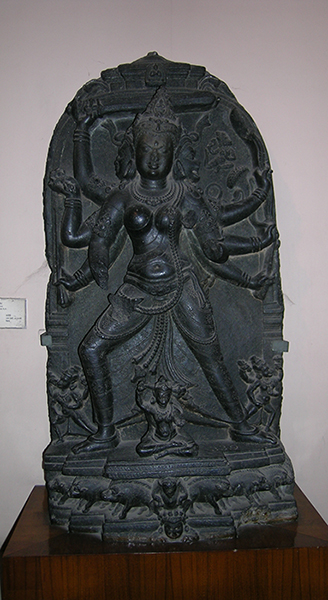
Given the quality of the sculpture, Buddhaśrīmitra seems to have had reasonable financial means. He may also have had an informed understanding of the image of the goddess Tārā, like the one described in a long sādhana done by an otherwise unknown paṇḍita-sthavira Anupamarakṣita.[51] Perhaps we could consider the image as an externalization of an internal vision of the goddess Tārā that Buddhaśrīmitra may have had at one point.[52] Is it possible that the idiosyncratic iconographic features, such as Akṣobhya and Amitābha floating around Tārā’s head and a unique rendition of Hayagrīva as a slender-bodied male figure holding a sword and a noose, may be related to Buddhaśrīmitra’s personal vision?[53] While his posture and gesture are that of a person engaged in a pūjā (pūjaka) rather than that of a sādhaka in meditation, it is also important to note that doing a pūjā is a standard component of a larger sādhana ritual.[54]
Incidentally, we find Buddhaśrīmitra’s name on another impressive yet idiosyncratic image of a goddess. A stone stele of Mārīcī, the Buddhist goddess of light and victory, in the Indian Museum (3827/A25131) also hails from Nālandā (fig. 20). Despite iconographic differences, this image of Mārīcī shares stylistic features with Buddhaśrīmitra’s Tārā image, especially in the slightly boxy treatment of the face, physiognomic features, and ornamental details (fig. 21). The level of distinctiveness in iconographic details is also similar to what we see in Buddhaśrīmitra’s Tārā image. The two images may have been prepared in the same workshop.
The Mārīcī image is of a considerable size at almost forty-four inches and represents the goddess as a formidable, eight-armed, three-faced figure who stands in a heroic pose (pratyāliḍha). In addition to her usual attributes, such as a vajra, an arrow, a paśa (noose), an aṅkuśa (elephant goad), a branch of aśoka flowers, and a bow, this Mārīcī wields a sword, ready to strike (fig. 20).[55] A sword is not found in any known Sanskrit sādhanas of eight-armed Mārīcī and, as Bautze-Picron notes, swords are only found in the warrior-type Mārīcī images originating from the Nālandā region.[56] The iconography of the warrior type, eight-armed Mārīcī image with a sword is relatively heterogeneous, suggesting an experimental nature behind the images’ conception and production.[57]
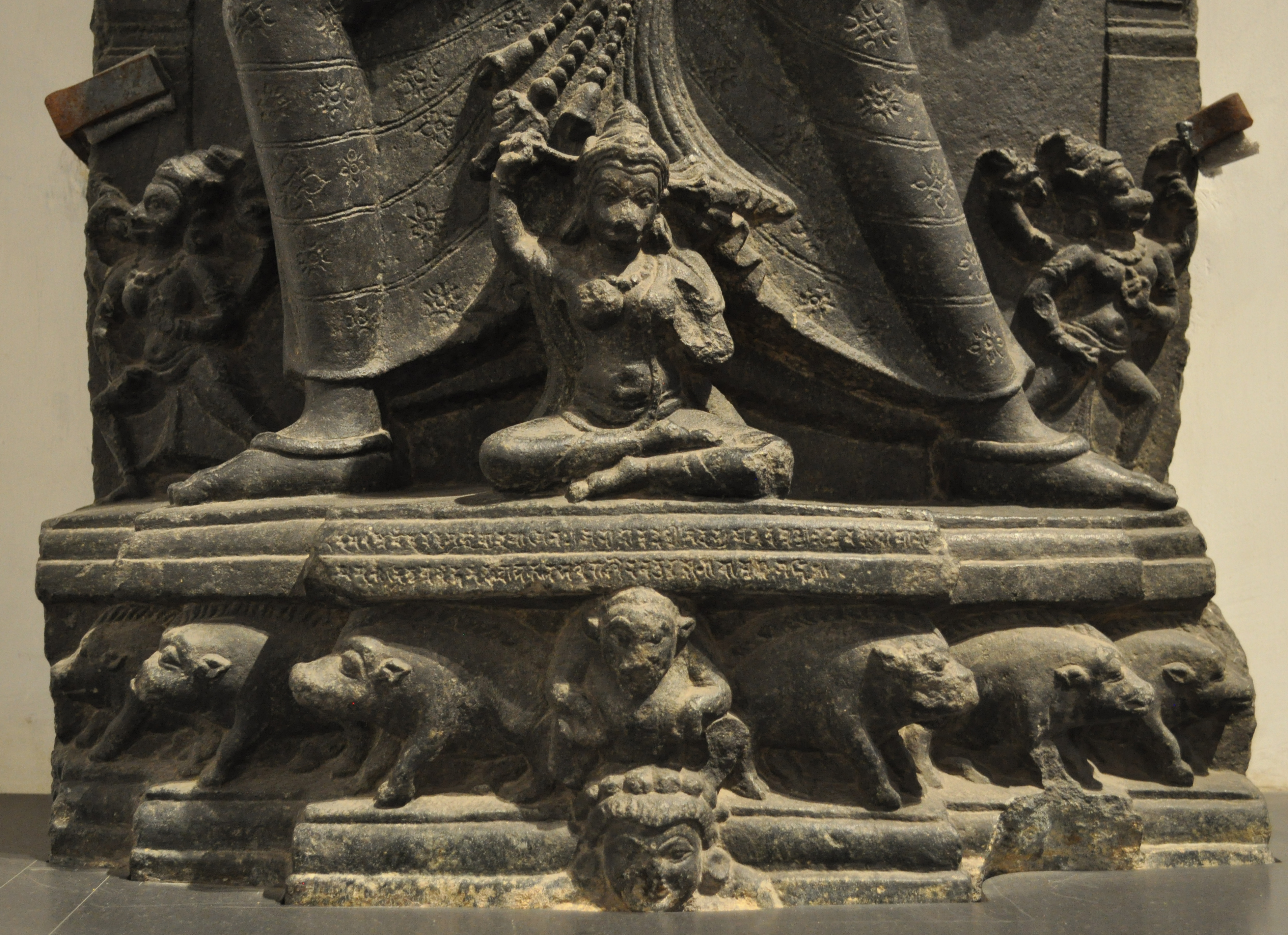
The Mārīcī image also features other unique iconographic formulations, especially in the depiction and arrangement of the attendant figures. Four female attendants are all sow-faced; two four-armed figures are on either side of Mārīcī’s feet. One appears in the position of a charioteer, but instead of holding the reins of the seven sows depicted below, she holds a long goad-like implement above her head, just like the main deity, as if about to whip the sows to go faster. A two-armed, sow-faced attendant appears above, flying right next to Mārīcī’s sow-faced left head, as if popping out of her now broken snout. Here, the principle of iconographic symmetry is not quite followed, as there is only a single flying attendant shown on Mārīcī’s left side.[58] The sow in the center squats facing forward as if riding or giving birth to Rahu, which is also unique to this stele.
One major difference between Buddhaśrīmitra’s Tārā and Nālandā Mārīcī image is the absence of a little donor figure in the latter. Yet, an inscription on the central projection (bhadra) of the pedestal, between the seated attendant and a Rahu-riding sow, gives us a surprising connection (fig. 21). This undated donor inscription gives the full Mahāyāna formula (deyadharmo ’yam mahāyānayayinaḥ . . . sakalasatvarāśer-anuttarajñānavaptaya-iti) in two lines, just like the donor inscription on Buddhaśrīmitra’s Tārā. We should first note that a full Mahāyāna formula on a stone stele is relatively scarce among the surviving corpus of sculptures, even from a big monastic center like Nālandā. In most cases, the donor inscription abbreviates the formula to “this is the religious gift of x.” According to this rather hard-to-read inscription, the donor of this formidable Mārīcī image is named Buddhaśrīmitra, just like the donor of the Tārā image.[59]
This serendipitous discovery gives us room to speculate a tantalizing historical relationship between the two images beyond that of stylistic grouping: as examples of the mid- to late tenth-century Nālandā style. Is it possible that the images share idiosyncratic iconographic details because they are both connected to Buddhaśrīmitra? Perhaps these two images record the visions of these two goddesses that Buddhaśrīmitra had sometime during the third quarter of the tenth century in Nālandā, which are not recorded in any other known textual sources. It is difficult to draw a definitive conclusion based on the available data, but I believe we have enough circumstantial evidence to suggest an exciting possibility of a donor’s vision practice informing the image-making process in late tenth-century Nālandā.
External images of personal, internal visions like these were most likely enshrined to receive various ritual offerings rather than put on a niche on the exterior of a shrine. While a monk engaged in a ritual activity is absent on the Mārīcī stele, the goddess is already enshrined by the architectural frame with a short, doubly receding rectangular superstructure. A caitya (lit. a mound or a place of worship containing a stūpa) became a part of Mārīcī’s iconography, with some sādhanas describing her as emerging out of caityagarbha, but this architectural framing device is not just an iconographic feature incorporated to emphasize her doctrinal importance. It conditions how we see an image.
Architecture of Image, Frame of Vision
As seen in figure 14, images from Magadhan Buddhist sites often do not have any architectural framing device unless one is iconographically required. However, many of these images were probably installed with more architectural elements such as supporting slabs or pedestals, decorated pillars, and crowning structures. For example, the majestic image of the Buddha in earth-touching posture from the valley of Hasra Kol (about twenty kilometers south of Kurkihar) now sits without any framing device in the Patna Museum so all may admire the sculpture’s incredibly crisp and smooth carving (fig. 23). But the image was originally framed with an elaborate throne behind him and a pedestal with pañcaratha (three receding projections with the foremost projection in the center, creating five rectangular spaces) layout, as seen in a photograph published by A.W. Keith in 1910 (fig. 23).[60]
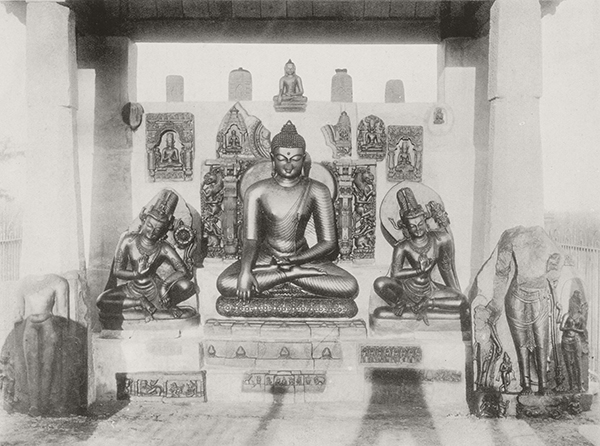
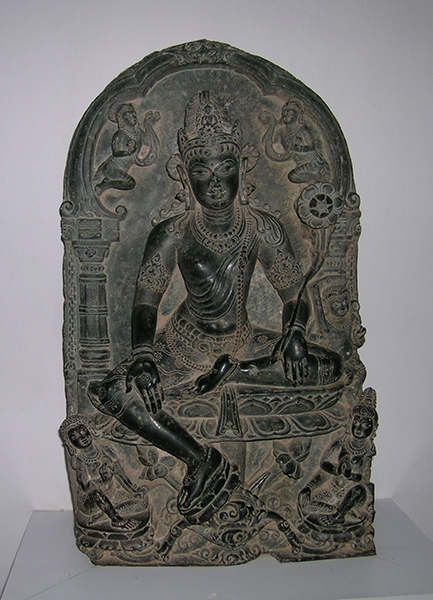
A rare example of a stele of Avalokiteśvara with an architectural framing device in its composition hails from Nālandā, the ever more experimental center where cutting-edge visions of the deities were articulated and externalized. This in turn suggests the presence of highly visually trained monastic persons and exceptionally skilled artisans (fig. 24).[61] Avalokiteśvara sits gracefully in a posture of ease (lalitāsana) on a rising lotus stalk, gently giving boons with an open palm, while Tārā and Bhṛkuṭī look up in adoration from below and a chubby figure of Hayagrīva guards the bodhisattva from behind. A tri-lobed arch supported by two hexagonal pillars and a cornice with crown molding, from which hangs a chain or tassel on either side, frames the stele. On the apex of the arch is a face, almost like a kīrtimukha (lit. face of glory), which is commonly seen on the apex of eleventh- and twelfth-century steles from both northern and southern Bengal but is less common on sculptures from Bihar.[62] This simple architectural frame helps keep our vision focused on the central deity, serving as a rudimentary but effective zooming device, like a telescopic tube.
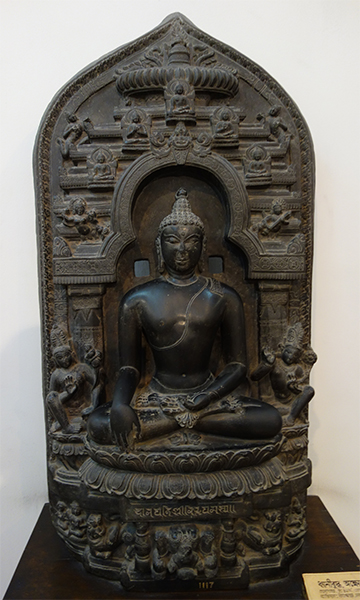
An architectural structure framing a central deity is taken as a regionally specific stylistic motif found mostly in images from Southern Bengal, especially in the Dhaka region, and often studied for its value in reconstructing the lost architecture of medieval Bengal (fig. 25).[63] In the context of considering images’ performative aspect, I propose to probe the possible cultic and ritual significance that can be enhanced if we interpret the architecture as a frame device that enhances our vision. For this purpose, I will focus on a single image: a circa eleventh-century stone stele of the Buddha from Vikrampur (Munshiganj district, south of Dhaka city) now in the National Museum of Bangladesh (acc. no. 1117).
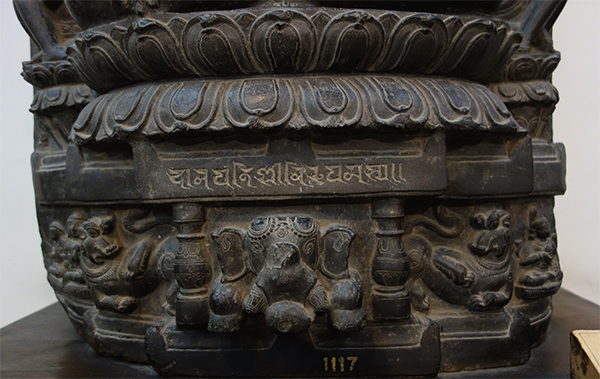
In the center of the stele sits the Buddha, displaying the earth-touching gesture. Two bodhisattvas, Maitreya on his right and Avalokiteśvara on his left, sit in ardhaparyaṅka (with one knee raised). They are hierarchically scaled and considerably smaller than the Buddha. Both hold up their right hands, palms facing outward. Their bodies are slightly turned to the center. By choosing to depict their opposite knees raised (Maitreya’s right knee and Avalokiteśvara’s left), the artist successfully created a visual barrier to draw one’s attention to the firmly crossed legs of the Buddha.
The Buddha sits on a double-lotus seat carved with a great sense of volume and crispness. This seat is raised above an impressive pedestal again of the pañcaratha type. We will come back to this pedestal momentarily, but it is worthwhile to note the molded eves and the ornamented bulbous pillars, between which juts out a massive elephant with ornamented trunks. The Buddha is framed by a tri-lobed arch with a kīrtimukha on the apex. Two ornamented octagonal pillars support the arch, which forms an opening of a multilayered shrine structure (known as “bhadra type”) that rises above.[64] Kinnara and kinnari perched above the horizontal bars on either side of the Buddha’s head is a common motif in the throne-back iconography and evokes the sense of collapsing spaces between an implied throne back and receding terraces of the shrine structure. The shrine is topped with an amalaka (lobed disc) and a stūpa-shaped finial. Five tathāgatas—Ratnasambhava (south), Vairocana (center), Akṣobhya (east), Amoghasiddhi (north), and Amitābha (west)—appear as if affixed on the terraces of this shrine structure.
The material, a black stone (most likely chloritoid phyllite), is carved and treated to convey an exceptionally full and smooth body of the Buddha with metallic lustre.[65] The busy superstructure and other periphery elements help create an optical zooming-in device. Our eyes do not wander on the surface of this stele, thanks to the hierarchical configuration of all the iconographic and architectural elements described above. There is a sense of projecting forward and zooming into the center, with the majestic Buddha on his double-lotus seat; once one reaches the center of composition on his chest, there is a sense of vertical movement rising upward and pulling downward while spatially receding backward. A controlled movement of one’s vision that zooms in on the central deity, which can eventually be dissolved in all directions, is how a practitioner (referred to as a mantrin or yogin in sādhanas) is instructed to engage in the practice of “seeing” (—√dṛṣ, √paś are the common verbs used for “seeing”) in sādhanas.[66]
Given the exceptional quality of carving and the fine-grain stone material, which was probably imported from far up the river, this must have been a costly production.[67] Those involved in its production, including a religious master who may have provided the mental image, a lay sponsor who financed the project, and the artists who materialized such a vision, were probably proud of this magnificent, deeply three-dimensional stele. Under the double-lotus seat of the Buddha on the center projection of the lower register is an inscription carved in exceptionally clear and beautifully written letters (fig. 26). It reads “dānapatiśrīnirupamasya” (of the donor (dānapati), Śrī Nirūpama).[68] This clear announcement of ownership is quite interesting considering that the stele is more than an image—it is effectively a caitya in the sense of a shrine for veneration and ritual activities.[69] It is as if this stele is a personal shrine of the donor.
The donor of this image, Nirūpama, appears kneeling in añjalī mudrā with a diminutive female (most likely his wife) behind him on the most recessed, far left side of the lower register (fig. 27). Nirūpama is turned sideways toward the center while his wife looks straight outward. In comparison to the monastic donors from earlier Magadhan sculptures (figs. 10, 12), these lay donors do not connect directly with the divine world above. They look more submissive than monastic donors. In fact, they may not be paying homage to the Buddha and his retinue above but rather to the figure depicted on the opposite side on their level (fig. 29). A male figure seated cross-legged holds a vajra and a ghaṇṭa and wears a conical headgear. Simple and concise lines effectively render his ornaments, such as armbands and shoulder plates. As Linrothe demonstrates, a miniature image of a human figure like the one we see in this stele represents an initiated practitioner, an ācārya, who clearly emulates the iconography of Vajrasattva, the Adi-Buddha and the guru of the five tathāgatas, and collapses the divine world and the human world.[70] While the examples Linrothe discussed have an ācārya as a donor-practitioner, here we have an image of an ācārya as a human teacher to Nirūpama and his wife, whose role may be akin to that of Vajrācāryas as family priests in today’s Nepal. He serves as an intermediary between the human world of the lay donors and the divine world above. It is as if the image of the divine world above them has been conjectured through his spiritual power and ritual mastery.
As in the case of earlier monastic donations from Magadha, the images of the eleventh and the twelfth centuries continue to articulate and reinforce the hierarchical ordering of the universe, conveying the prevailing Esoteric Buddhist worldview while inspiring anyone with a privilege to see it to act accordingly. Certainly, on the marvelous stele of Khasarpaṇa from Mahākālī mentioned at the beginning of this essay, we see the social hierarchy among laity conveyed through the visual data. Of the three human figures depicted on the lower left corner of the stele (fig. 29), a male figure holding a garland may be the main donor. Instead of kneeling, he sits upright with his legs crossed. In the absence of an ācārya, he seems to have taken a position of authority. Behind him kneels a woman, who appears to be the most submissive of the three, with her head tilted downward and shoulders slightly raised. Underneath the main donor is another male figure seated in prayer with his head tilted downward. He appears smaller and more slender than the main donor above, indicating his subordinate social status, perhaps as a junior member of the family.
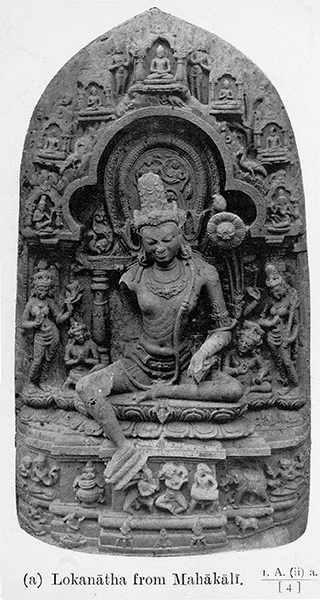
Epilogue: Aesthetic Response in Buddhist Art and Śṛṅgāra Rasa
Let us now go back to the questions raised at the beginning on the affective nature of a Buddhist image, with the example of the Khasarpaṇa stele in the National Museum of Bangladesh, Dhaka (figs. 4, 30). According to Bhattasali, the stele was found at Mahākālī, a village south of the ancient city of Vikramapura, an important political center of medieval Bengal. The image seems to have suffered further damage since it was first photographed in the 1920s in the village of Nāhāpārā.[71] As we can see in figure 31, his highly matted lock of hair (jaṭā-mukuṭa) has been broken off, and his left hand has been severed in the middle of the forearm. Despite these accidental damages, the image’s artistic merits remain uncompromised. The bodhisattva’s body is incredibly three-dimensional, as suggested by the hallowed space behind his torso.
If a simple architectural frame of the Avalokiteśvara from Nālandā in figure 25 helps to contain and control our way of seeing that image, the elaborate architectural setting with ornamented tri-lobed arch and corniced pillars in the Dhaka stele multiplies this effect. An intricately sculpted mountain landscape is filled with upturned petal or flame-like formal features rendering its rocky nature, and each of the five tathagatas is set in a cave of his own against this backdrop. The rich surface texture gives our vision a sense of elasticity as the tri-lobed arched frame of the main scene is repeated seven times in slightly varying scales (fig. 31). The stele’s architectonic character is further enhanced by the treatment of the lower register, where an additional projection is indicated, creating two additional pratibhadra projections (we see seven horizontal blocks instead of five). Given the exceptional quality of carving and the sophistication of design and composition, we can safely suggest that the image’s patron was resourceful and economically capable. The inscription on the central projection is the “ye dharmahetu . . .” formula, and the name of the donor remains unknown. As we’ve seen before, a family of the lay patron is represented on the stele, and the main donor is shown in the position of authority.
The artistic articulation of visual details and realization of what I would like to call an “elastic optical effect” may be spectacular, but the iconography of the stele is more or less standard, conforming to the vision of Khasarpaṇa described in a number of sādhanas. Here, the artist’s ability and input may have mattered more in determining the resulting externalized image than a person’s internal vision. The image’s cultic function is indicated by devotees kneeling in prayer and offering a flower garland. As we see in figure 32, two bowls of food offerings are placed on tripods. A kalaśa (water vessel) topped with a conch and leaves is also a standard accouterment of a pūjā, and the appearance of saptaratna (the seven jewels of cakravartin: elephant; horse; treasurer/gṛhapati, represented here as a slender male; female consort/strī; wheel; jewel/maṇi; and a commander, represented here with a sword) on the opposite side of lay donors enhance the worldly glory of the image. The image was probably installed to receive manifold offerings as a central focus of a pūjā.[72]
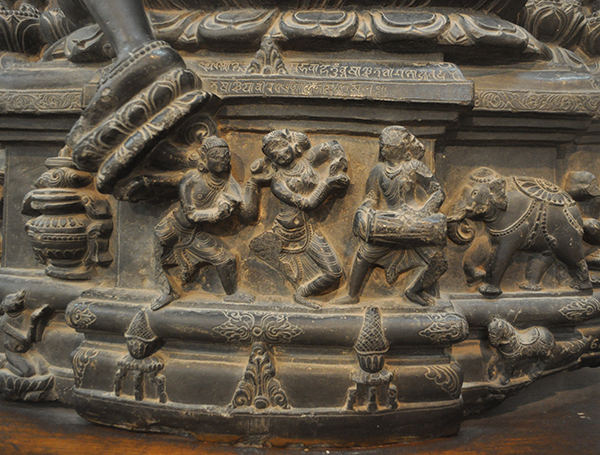
Whether the image was appreciated for its aesthetic quality is difficult to establish. Asking what emotions and aesthetic responses this image may have evoked in the eleventh century may be throwing a premodern religious image under the tyranny of modernism. Yet, there is a tantalizing possibility to consider the image in terms of Indian aesthetic theory of rasa (lit. nectar, juice, taste), especially around the concept of śṛṅgārarasa or “erotic sentiment.” A Khasarpaṇasādhanam (SM No. 14) attributed to one Padmākaramati articulates Khasarpaṇa’s quality in following terms: He is “charming with compassion (karuṇāsnigdha),” “served with erotic sentiment (śṛṅgārarasaparyupāsitam),” “extremely peaceful (atiśāntam),” and “endowed with various auspicious marks (nānālakṣaṇālaṅkṛtam).”[73]
The term śṛṅgāra-rasa as a descriptor for Khasarpaṇa’s quality also appears in the sādhana by a monastic author, sthavira Anupamarakṣita: Khasarpaṇa Lokeśvara is described as a “charming form blazing with the most excellent śṛṅgāra paramaśrṅgārojjvalaramaṇiyamūrttiṁ.”[74] The use of the term śṛṅgāra is rather unusual, and how artists may have tried to convey such a quality is difficult to assess. The extreme plasticity and sinuousness of Khasarpaṇa’s body may be taken as one approach. But we may also understand this descriptor in a larger cultural and religious landscape and consider śṛṅgāra rasa’s association with the Kṛṣṇa bhakti movement, which in Bengal had a lasting and pervasive impact during subsequent centuries with Jayadeva’s Gita Govinda (circa 12th century), Caitanya Mahaprabhu (circa 1486–1534), and Gauḍiya Vaiṣṇavism. In this light, the joyous and uplifting mood conveyed by two male musicians and a female dancer, placed right under the bodhisattva in the central projection of the bottom register, takes on a new meaning.
Dancing musicians occasionally appear on the bottom registers and pedestal slabs of Buddhist steles, which is taken as part of ritual offerings like those described in the Mañjuśrīmūlakalpa.[75] But context in which music is used in the Mañjuśrīmūlakalpa is rather serious and does not seem to suggest any active movement.[76] Another place we find a reference to the use of music is in a processional context, accompanying an image carried around during a festival.[77] A seventh-century Chinese monk, Seng-che (僧哲), reported one such procession that he witnessed during his sojourn in Bengal: “the procession of the statue of Avalokiteśvara on carriage, accompanied by monks and followed by the king, with pomp of banners, drum beats and music.”[78] Here, too, it is difficult to imagine any people dancing ecstatically.
As seen in figure 33, the female dancer in the middle of the scene is shown in such an energetic sway, with her upper body and head tilted to her right while her arms move up toward her left. She is precariously balancing on her bent left leg. A musician to her right is bending toward her with his raised left hand holding a cymbal, almost touching her. A drummer to her left is caught in a moment of lifting his left heel to move his stance. The excitement and joy conveyed in the scene reminds me of Kṛṣṇa’s līlā with a circle of ecstatic dancers, which would later adorn the temple walls of Bengal, or singing and dancing frequently practiced in Gauḍiya Vaiṣṇavism. Our Khasarpaṇa stele predates the spread of Kṛṣṇa bhakti in Bengal and the composition of the Gita Govinda, the quintessential text of śṛṅgāra rasa, but the idea of Kṛṣṇa’s līlā is known from an earlier text like the Bhāgavata Purāṇa.[79] While only further research will explain the historical context and period-specific meaning of śṛṅgāra rasa in a Buddhist context, I think the Khasarpaṇa image allows us to see a vignette of performances that may have been part of a growing epistemological shift in theology. If śṛṅgārarasa was a buzzword, a few authors of sādhanas presented a Buddhist response to it through the image of Khasarpaṇa. In the hands of a master Bengali artist, this vision was successfully externalized so all could enjoy that intense uplifting sentiment. Whether the image elicited this type of joyous dancing on the part of devotees is impossible to know. At least the image tells us that it was one of the possible, permissible, and perhaps encouraged activities.
Author’s Note
I am grateful to the members of my freshman seminar at Harvard, Max Moulton, Nina Srivastava, Hellary Zhang, and Emma Talkoff, for their thoughtful and enthusiastic participation in examining the physical and ritual context of images in the Thai Buddhist temple discussed at the beginning of the essay. The Elson Family Arts Initiative Fund supported the seminar’s multiple field trips in fall 2014. I thank Swapan Biswas of the National Museum of Bangladesh for his kind support for my research. I also thank Abdul-Muyeed Chowdhury, Sumala Chowdhury, Shihab uddin Ahmed, and Shanul Haque Sumon for facilitating my research in Bangladesh. I am deeply grateful to Anasua Sengupta (Indian Museum) and Subir Sarkar (AIIS) for their help with my research in Kolkata. Many thanks are due to Michelle C. Wang and Wei-Cheng Lin for inviting me to participate in this volume and for spearheading the project. I thank Robert Linrothe, Nicholas Morrissey, Claudine Bautze-Picron, and Parimal Patil for providing much-needed references and sharing their insights. I would like to express my sincere gratitude to two anonymous reviewers for their constructive comments and insightful suggestions. I also thank the journal’s editor, Nancy Micklewright, and the editorial team for their support. All errors remain mine.
A GRI-NEH fellowship supported a research leave during which part of the research for this study was conducted. In acknowledging NEH support, I declare any views, findings, conclusions, or recommendations expressed in this article do not necessarily reflect those of the National Endowment for the Humanities.
Notes
Wat Nawamintararachutis, 382 South St., Raynham, Massachusetts.

According to the introductory statement on the temple’s website, Wat Nawamintararachutis is open to “people of all races, nationalities and backgrounds” and the temple strives to lend support to the cultural needs of larger Asian American communities in the region. http://watnawamin.org/about, accessed March 21, 2015.

The main building with green gabled roofs fit nicely with the rural New England landscape. It is topped with a grand golden chedi finial, signaling its Thai Buddhist identity, and it houses a museum on the first floor, a meditation hall on the second floor, and a main temple on the third floor. The building was designed by a team from ARC/Architectural Resources Cambridge with input from Thai architects, and designing and planning the temple’s construction involved extensive discussions with the city council of Raynham. For more pictures of the building’s architecture, see http://arcusa.com/node/71. The temple’s executive committee’s concern to fit with the context of New England’s cultural landscape is clearly reflected in the final outcome.

Including images of monks in the posture of reverence to the Buddha as the foremost devotees has a long history in Southeast Asia. A well-known example is in the Ananda Temple in Bagan, Myanmar, where wooden statues kneeling on either side of the colossal standing Buddha image depict Monk Shin Arahan on the opposite side of the King Kyanzittha (r. 1084–1113), the temple’s royal patron. As Claudine Bautze-Picron insightfully observes, most examples from early medieval South Asia represent a particular, individual monk, especially in the immediate context of donation. Bautze-Picron, “Images of donors in the Buddhist art of Eastern India,” submitted to HAL archive on December 17, 2014, HAL ID: hal-01096358. I would like to emphasize here that a historical reading does not necessarily exclude such figures’ more universal meaning.

The suggested connection between an image’s iconography and a devotee’s ritual behavior does not mean that the image prompted the devotee to behave in certain ways. For those growing up within the tradition, i.e., as a Thai Buddhist, how to behave in a temple is often learned through years of experience, mimicking the elders in the family and community. How to kneel in a specific manner or how to sit cross-legged is a culturally learned behavior. While an image of a kneeling monk may not instruct a visitor to behave in a certain way, it represents the archetype and a model for the encouraged ritual behavior, supporting the moments of instructions that may happen with first timers.

Frederick M. Asher, "The Former Broadley Collection, Bihar Sharif," Artibus Asiae 32, no. 2/3 (1970); Janice Leoshko, Sacred Traces: British Exploration of Buddhism in South Asia, Histories of Vision; (Aldershot, Hants, England; Burlington, VT: Ashgate Pub., 2003); "A Matter of Perspective in the Study of Buddhist Art," Journal of Bengal Art 2 (1997).

Another important factor contributing to the dispersal of the Buddhist images is the practice of appropriating older images for devotional purposes. In Orissa, for example, there is no shortage of Buddhist images that are currently installed for worship in “Hindu” context, as collected in Donaldson’s extensive study on Buddhist sculptures of Orissa. See Thomas E. Donaldson, Iconography of the Buddhist Sculpture of Orissa, 2 vols., vol. 1 (New Delhi: Indira Gandhi National Centre for the Arts: Abhinav Publications, 2001). The history of appropriation of religious images in Indic context is a complex one, and it is beyond the scope of this study. Richard Davis’s discussion of the early medieval practice of looting and appropriation is a good place to begin exploration. See Richard Davis, Lives of Indian Images (Princeton: Princeton University Press, 1997). Padma Kaimal’s recent study provides insight to understanding the historical process of appropriation and re-appropriation that is unique to Indian context throughout time. Padma Audrey Kaimal, Scattered Goddesses: Travels with the Yoginis (Ann Arbor, Mich.: Association for Asian Studies, 2012).

Benoytosh Bhattacharyya, Sādhanamālā, 2 vols., vol. 1, Gaekwad's Oriental Series (Baroda: Oriental Institute of Baroda, 1925; repr. 1968), 39–41.

These compilations are collected as a uniform text by Benoytosh Bhattacharyya. See Jinah Kim, "Local Visions, Transcendental Practices: Iconographic Innovations of Indian Esoteric Buddhism," History of Religions 54, no. 1 (2014), 37.

Of course, this step is not as straightforward and easy as presented with the example of Khasarpaṇa; some images with unusual features will throw scholars down a rabbit hole in search of identity in textual sources. In addition, it is typical to find multiple epithets attached to a deity in ritual contexts.

Claudine Bautze-Picron, "Between Men and Gods: Small Motifs in the Buddhist Art of Eastern India, an Interpretation," Function and Meaning in Buddhist Art: Proceedings of a Seminar Held at Leiden University, 21–24 October 1991, ed. K.R. van Kooij and H. van der Veere, Gonda Indological Studies (Groningen: Egbert Forsten, 1995); "Images of Donors in the Buddhist Art of Eastern India" (2014), https://hal.archives-ouvertes.fr/hal-01096358.

Janice Leoshko, “About Looking at Buddha Images in Eastern India,” Archives of Asian Art 52 (2000/2001), 63–82.

A good example appears in the pedestal of a sculpture from Bodhgaya photographed by Cunningham (now in the British Museum). The image’s whereabouts are unknown, but we can see that the inscription in the middle identifies the image as the pious gift of Dhāduka (deyadharmoya[ṃ]dhādukasya); the four human figures have accompanying inscriptions, which seem to be their names. The male figure holding the censer on the left is identified as Dhāduka. See Michael Willis, The Archaeology of Hindu Ritual: Temples and the Establishment of the Gods (New York: Cambridge University Press, 2009), fig. 42. Dan Martin’s study of the eleventh- and twelfth-century Tibetan thangkas establishes that the patron of a thangka could commission his teachers and himself to be represented in the painting. Dan Martin, “Painters, Patrons and Paintings of Patrons in Early Tibetan Art,” Embodying Wisdom: Art, Text and Interpretation in the History of Esoteric Buddhism, ed. Rob Linrothe and Henrik H. SØrensen (Copenhagen: Seminar for Buddhist Studies, 2001), 142–46. Also see the discussion on the fruitful mirrored relationship between the representation of a donor/practitioner and the image of Vajrasattva in Rob Linrothe, “Mirror Image: Deity and Donor as Vajrasattva,” History of Religions 54, no. 1 (August 2014), 5–33.

Phyllis Granoff, “Patrons, Overlords and Artisans: Some Comments on the Intricacies of Religious Donations in Medieval Jainism,” Bulletin of the Deccan College Research Institute 54/55 (1944–95), 269–91. I thank Nicholas Morrissey for this important reference.

Scholarship on the relationship between the temple patronage and sociopolitical prestige is most developed in South Indian context. For example, see the discussion in Cynthia Talbot, “Temples, Donors, and Gifts: Patterns of Patronage in Thirteenth-Century South India,” The Journal of Asian Studies 50, no. 2 (May 1991), 308–40. While it is difficult to generalize without a thorough survey of surviving material from eastern India, from the data I have documented and surveyed regarding female patronage of medieval Indian Buddhist art, I can report that stone steles that bear donor images shown with elaborate ornaments are those prepared with high artistic caliber.

Ronald Davidson, Indian Esoteric Buddhism: A Social History of the Tantric Movement (New York: Columbia University Press, 2002), 25–74.

The introduction of a ritual master (vajrācārya) figure in lay image donations and the decrease of monastic donors in representation are noticeable differences in the later images.

A comprehensive analysis of sādhanas will help us better understand the nature of Esoteric Buddhist practices and their relationship to images, which is beyond the scope of this study. For an example, see the Tārāsādhanam translated in Louis O. Gómez, "Two Tantric Medittations: Visualizing the Deity," Buddhism in Practice, ed. Donald S. Lopez Jr. (Princeton: Princeton University Press, 1995), 318–27.

Jinah Kim, “Local Visions, Transcendental Practices: Iconographic Innovations of Indian Esoteric Buddhism,” History of Religions 54, no. 2 (August 2014), 34–68.

Donor figures inserted in the iconographic composition are not unique to Buddhist context. Here, “Bengal” designates today’s Bengali speaking region, including West Bengal in India and Bangladesh.

Jinah Kim, "Seeing in between the Space: Aura of Writing and the Shape of Artistic Productions in Early Medieval South Asia," History and Material Culture in Asian Religions, ed. Benjamin Fleming and Richard Mann (London: Routledge, 2014).

Gregory Schopen, “Mahāyāna in Indian Inscriptions,” Indo-Iranian Journal 21, no. 1 (1979), 1–19; also in Figments and Fragments of Mahāyāna Buddhism in India: More Collected Papers (Honolulu: University of Hawai’i Press, 2005), 223–46; Jason McCombs, “Mahāyāna and the Gift: Theories and Practices” (PhD diss., University of California, Los Angeles, 2014), 311–86, table 2.

Kim, “Seeing in between the Space”; Daniel Boucher, “The Pratītyasamutpādagāthā and its role in the medieval cult of the relics,” Journal of International Association of Buddhist Studies 14, no. 1 (1991), 1–27.

Sarnath presents an exciting case in which a long history of Buddhist development in India unfolded at a single site, going through different stages of doctrinal development. Sarnath’s status as an important Buddhist pilgrimage site that also became an important site of monastic communities very early in its history is worth investigating further. Many Gupta period Buddha images were donations by members of the monastic community. Dating to the twelfth century, when the queen of the Gahāḍavāla dynasty (Kumāradevī) built a new monastery reinvigorating the site, examples of lay donation bearing miniature images of lay donors survive at the site. On an unusual stone stele of Vasudhārā (left) and Jambhala (right) in the ASI Sarnath museum, we see a man next to Vasudhārā’s right foot and a woman kneeling next to Jambhala’s left foot. Elaborate ornaments indicate their high socioeconomic status.

The lay donations in Magadhan Buddhist sites are abundant throughout the historical spectrum of available data. Monastic donations of images must have continued in the eleventh and the twelfth centuries in a place like Nālandā, as we know from the praśasti (eulogy) inscription of Vipulaśrīmitra, a monk of a considerable monastic status belonging to an illustrious lineage of śrīmitras, whose recorded activities of piety include installing images and building shrines for images. N.G. Majumdar, “Nālanda Inscription of Vipulaśrīmitra,” Epigraphia Indica 21 (1931–32), 97–101.

Ronald M. Davidson, Indian Esoteric Buddhism: A Social History of the Tantric Movement (New York: Columbia University Press, 2002). Christian K. Wedemeyer, Making Sense of Tantric Buddhism: History, Semiology, and Transgression in the Indian Traditions (New York: Columbia University Press, 2013). Wedemeyer’s observation that the status of those supposedly engaged in the most extreme forms of tantric rituals may have been temporary rather than permanent is helpful in thinking beyond rigid categorization.

Previous studies assume that these figures represent monks partly based on the similarity of their conical headgear and that of certain Tibetan monastic lineage fashion, but their monastic status in the sense of an ordained member of a saṅgha is far from clear.

Giving carved pillars, railings, and slabs was an established practice from the second century BCE, as seen in the Buddhist stūpa sites of Bharhut and Sanci. Early epigraphic evidence of independent image donations as religious gifts belongs to the Kushan period.

On the term’s definition and use, see Jason McCombs, "Mahayana and the Gift: Theories and Practices," especially chapter 2.

Gouriswar Bhattacharya, "Dāna-Deyadharma: Donation in Early Buddhist Records (in Brāhmī)," Investigating Indian Art: Proceedings of a Symposium on the Development of Early Buddhist and Hindu Iconography Held at the Museum of Indian Art Berlin in May 1986 (Berlin: Museum für Indische Kunst, 1987). As seen in a Gupta Vaiṣṇava royal inscription at Udayagiri, the term deyadharma also appears in non-Buddhist context from the fifth century onward. Willis, The Archaeology of Hindu Ritual, 57.

Miniature human figures on the bottom of an iconic image appear as early as Kushan period Gandhara sculptures. However, it is unclear whether most included in this position are supposed to represent donors or people from a narrative time. Certainly, there is a strong tendency to collapse different times into one frame in Indian art. For example, see Vidya Dehejia, Discourse in early Buddhist art: Visual narratives of India (New Delhi: Munshiram Monoharlal Publishers, 1997).

On Palola Ṣahī inscriptions, see Oskar von Hinüber, Die Palola Ṣahīs. Ihre Steininschriften, Inschriften Auf Bronzen, Handschriftenkolophone Und Schutzzauber:Materialien Zur Geschichte Von Gilgit Und Chilas, ed. Karl Jettmar and Bandini Ditte, Antiquities of Northern Pakistan: Reports and Studies 5 (Mainz: P. von Zabern, 2004). For Gilgit donor images, see the examples collected by Rebecca Twist, "Patronage, Devotion and Politics: A Buddhological Study of the Patola Sahi Dynasty's Visual Record," (PhD diss., Ohio State University, 2008).

Claudine Bautze-Picron, “Images of Donors in the Buddhist art of Eastern India,” HAL paper, 2014, hal-01096358, 1.

Among 109 undated votive inscriptions compiled by Hirananda Sastri in his report, we find seven monastic donations, of which five are marked by the title stha or sthavira. Hirananda Sastri, Nalanda and Its Epigraphic Material, Memoirs of the Archaeological Survey of India (New Delhi: Archaeological Survey of India, 1942, repr. 1999), 108–13.

Claudine Bautze-Picron proposes circa 850 CE as the date based on the stylistic similarities with the Itkhauri Tārā image that bears the eighth regnal year of Mahendrapāla. Claudine Bautze-Picron, "Crying Leaves: Some Remarks on the Art of Pāla India (8th–12th Centuries) and Its International Legacy," East and West 43, no. 1/4 (1993), 286–87.

Susan L. Huntington and John C. Huntington, Leaves from the Bodhi Tree: The Art of Pāla India (8th–12th Centuries) and Its International Legacy (Dayton, Ohio: Dayton Art Institute in association with the University of Washington Press, Seattle, 1990), 142.

The donor figures are never portraits of actual people in the sense of mimetic representation of their physiognomic appearance. Differences and identities are signaled through iconographic attributes, as in the case of Prajñāprabha being represented in a more relaxed manner and in a more spatially pronounced position, and physiognomic features often remain generic.

The LACMA image has four gavākṣa (lit. ox-eye, caitya-window) motifs above this lower register framing the area, whereas the AAMSF image has five gavākṣa motifs in the same area.

Janice Leoshko, "Scenes of the Buddha's Life in Pala Period Art," Silk Road Art and Archaeology 3 (1993–94); Idem, “About Looking at Buddha Images in Eastern India”; Hiram W. Woodward Jr., "The Life of the Buddha in the Pāla Monastic Environment," The Journal of the Walters Art Gallery 48 (1990).

The object held in his right hand is often identified as and may well represent an incense burner. I suggest a burning lamp and compare the action depicted with the practice of aarti to emphasize the devotional aspect highlighted in this image.

That the directions of gazes in Indian Buddhist art expect a viewer’s engagement can be explained in many different narrative contexts. I thank Daniel Borengasser for drawing my attention to one example at Tabo. In a recent study, Catherine Becker demonstrates how certain visual clues were creatively used to address viewers in narrative panels. Catherine Becker, Shifting Stones, Shaping the Past: Sculpture from the Buddhist Stūpas of Andhra Pradesh (Oxford University Press, 2015). The relationship between the performative scenes in the stone steles of eastern India and visual narratives in Indian Buddhist art merits further explication, but it is beyond the scope of the current study.

Here, it is interesting to note Gregory Schopen’s translation of a passage from the Mūlasarvāstivāda-vinaya that lays out the rules regarding the procession of an image for a festival. The passage also highlights the importance of seeing an image, which Schopen translates as “they wished to have darśan of it [the image and/or the festival].” Gregory Schopen, “Taking the Bodhisattva into Town: More Text on the Image of ‘the Bodhisattva’ and Image Processions in the Mūlasarvāstivāda-vinaya,” East and West 55, no. 1/4 (December 2005), 308. The use of the term darśan is Schopen’s intervention, as he suggests in the accompanying footnote (no. 38). In the context of the image making and use from the fifth century onward, the term darśan seems to be quite profitable for more fruitful discussion of images’ meaning and function.

For a comparable example in near contemporary Tibetan context, see Martin, “Painters, Patrons and Painting.”

The image hails from the Nālandā area although the museum label wrongly identifies the production site as Kurkihar. Asher, "The Former Broadley Collection, Bihar Sharif," 109.

A slender male figure standing with a sword in his right hand and a noose in his left hand is an intriguing iconography for Hayagrīva. Linrothe points out Hayagrīva iconography is mainly articulated by a vāmana, or pot-bellied dwarf-type body. This slender male figure looks similar to Aśokakanta Mārīcī, who frequently holds the same post in Tārā images from the Magadhan sites. Robert N. Linrothe, Ruthless Compassion: Wrathful Deities in Early Indo-Tibetan Esoteric Buddhist Art (Boston; New York: Shambhala, 1999), 104–5.

Sādhanamālā [henceforth SM], vol. 1, no. 204. See the translation in Louis O. Gómez, "Two Tantric Medittations: Visualizing the Deity," Buddhism in Practice, ed. Donald S. Lopez Jr. (Princeton: Princeton University Press, 1995), 326. My suggestion of light rays in the center is partly informed by Bautze-Picron’s reading of the spatial arrangement of Akṣobhya-Vairocana-Amitābha across a manuscript’s iconographic structure, as related to the movement of the sun. Claudine Bautze-Picron, "Buddhist Painting During the Reign of Harivarmadeva (End of the 11th C.) in Southeast Bangladesh," Journal of Bengal Art 4 (1999), 186–87.

Due to the surface damage around the area, it is difficult to read three letters in front of Buddhaśrīmitra. They may read “stha vya ya.”

N.G. Majumdar, “Nalanda Inscription of Vipulasrimitra,” Epigraphia Indica 21 (1931–32), 97–101; Richard Salomon, Indian Epigraphy (New York and Oxford: Oxford University Press, 1998), 297–302.

“Kincidvistram-Tārāsādhanam (Somewhat Long Tārā Sādhana)” SM 98, 200–206. He is the author of a few sādhanas, including one on Khasarpaṇa titled “Kincidvistram-śrīkhasarpaṇalokeśvarasādhanam (SM 24), which is also an elaborate, long version like the Tārāsādhanam.

I find it useful to offer the following anecdote as an analogy. In a household Durgā pūjā I observed in Kolkata in 2003, I noticed that the arrangement of Mā Durgā’s children (i.e., Gaṇeśa with his wife-plantain tree, Kārttikeya, Saraswatī, and Lakṣmī) was different from everywhere else. When I asked about this peculiar placement, a family member explained to me that they arranged them in the variant manner that switched the placement of Gaṇeśa and Kārttikeya (which resulted in Gaṇeśa being separated from Kola bou, considered his wife in Bengal) because their grandfather had a dream in which Mā Durgā appeared with her children in this manner. While this is a twenty-first-century anecdote, it asks us to consider how religious iconography may not be as dogmatically strict and static as we often assume. I thank Satyakam Sen of the Indian Museum and his wife for giving me a chance to observe and participate in a household pūjā.

For discussion of the possible relationship between a personal vision and an image’s iconography, see Kim, "Local Visions, Transcendental Practices.”

In the “Somewhat Long Tārāsādhanam” (SM 98), a practitioner is instructed to do a manifold pūjā following the visualization of the deity. SM 205; Gómez, "Two Tantric Meditations: Visualizing the Deity," 326.

On four types of Mārīcī iconography, see Jinah Kim, "Emergence of a Buddhist Warrior Goddess and the Historical Devevlopment of Tantric Buddhism," Journal of the Indian Society of Oriental Art n. s. 28–29 (2013).

Claudine Bautze-Picron, "Between Śākyamuni and Vairocana: Mārīcī, Goddess of Light and Victory," Silk Road Art and Archaeology (2001).

This supports Huntington’s suggestion that the artists around monastic centers like Nālandā are “bold in their acceptance and perpetuation of a wider range of iconographic forms.” Susan L. Huntington, The "Pāla-Sena" School of Sculpture, (Leiden: E.J. Brill, 1984), 116. I thank Sunitha Das for this reference. It also suggests that the process of proliferation of various iconographic forms in late Indian Buddhism was based on personal and localized experience. See Kim, "Local Visions, Transcendental Practices."

A more typical approach would be to have two flying figures on either side or to have the single figure flying above in the center, as seen in a miniature stele of Mārīcī of the same type in the Nālandā Site Museum. Bautze-Picron, "Between Śākyamuni and Vairocana: Mārīcī, Goddess of Light and Victory," fig. 6.

In its current condition, it is difficult to read the inscription in situ. Here, too, his name is preceded by three characters, which seem to read slightly differently from what we see on the Tārā image.

According to Keith’s report, the image along with its companion bodhisattvas (also in the Patna Museum) was moved to the nearby village of “Bishenpur (Vishnupur)” along with “the back of the throne, the pedestal with inscription and two broken parts of another pedestal with carved lions, also a small panel” when Mr. Beglar first noticed in or about 1867. The whole group was moved and reinstalled for safekeeping in or about 1908, and “the three principal images occupy the same relative position they held in the valley, only now face east instead of north.” A.W. Keith, "Notes on Somes Buddhist Remains in Magadha," Bengal, Past & Present: Journal of the Calcutta Historical Society 6 (1910), 60.

A kīrtimukha motif marking the apex of a tri-lobed arch framing an image underneath is used in Magadhan sites on the architectural members of a caitya or a shrine structure from the eleventh century onward.

Nalini Kanta Bhattasali, Iconography of Buddhist and Brahmanical Sculptures in the Dacca Museum (Dacca: Dacca Museum Committee, 1929), xii–xvii; Eun-Su Lee, "On Defining Buddhist Art in Bengal: The Dhaka Region" (PhD diss., University of Texas at Austin, 2009), 233.

S.K. Saraswati, Architecture of Bengal, book 1 (Calcutta: G. Bharadwaj & Co., 1976), 67.

Lee uses a concept of “yoga-body” as the principle behind the shining surface treatment of Buddhist sculptures from southern Bengal. It is an interesting idea, but its blanket use needs to be critically assessed. If this concept is drawn from sādhana practices of Esoteric Buddhist traditions, as Lee seems to assume, it does not explain why the artistic practice of polishing the stone to a metallic shine was mostly limited to the Dhaka area. Lee, “On Defining Buddhist Art in Bengal,” 119–22.

For example, see the translation of the long Tārā-sādhana (“Kiñcid-vistaraṃ tārā sādhanam”) in Gomez, "Two Tantric Meditations: Visualizing the Deity," 321–26. Also see the iconographic descriptions in Benoytosh Bhattacharyya, Indian Buddhist Iconography: Mainly Based on the Sādhanamālā and Cognate Tāntric Texts of Rituals (Calcutta, Firma K. L. Mukhopadhyay, 1958, 2nd ed., rev. and enl.). The English translations of the sādhanas’ descriptive passages offered by Benoytosh Bhattacharyya do not necessarily convey the sense of movement in visualizing a deity, but the order suggested in the Sanskrit text indicates the movement rising upward from below, i.e., rising from the moon disc/orb (candramaṇḍala) and built upward, and then moving from (the impression of) the whole to specific parts.

The quarry of this type of fine grain black rock is located near today’s Lakhi Sarai in the Matadih quarry. Frederick M. Asher, "Ston and the Production of Iage," East and West 48, no. 3/4 (1998).

The formula here is quite different from the deyadharma formula on Magadhan examples we examined earlier. Further research will help us understand the socioreligious significance of this formula, which seems to appear in the late eleventh- and twelfth-century donations, but this is beyond the scope of the current study.

The term caitya can denote a stūpa (relic mound), a “sacred tree growing on a mound, hall or place of worship,” a “sanctuary near a village,” or “a Jain or Buddhist image,” according to the Monier Williams Sanskrit–English Dictionary, while Edgerton’s Buddhist Hybrid Sanskrit Grammar and Dictionary has “any object of veneration.”

Linrothe, “Mirror Image: Deity and Donor as Vajrasattva,” 28–29. Linrothe notes “ācārya” is “mentioned in inscriptions on sculptures by a donor dedicating the work to his ācārya.” While this is correct, it is also important to remember that this ācārya appears in the context of the Mahāyāna donor formula, where the merits of donation are dedicated to “teacher, mother and father, and all sentient beings” and a specific donor’s teacher is not mentioned.

Nalini Kanta Bhattasali, Iconography of Buddhist and Brahmanical Sculptures in the Dacca Museum (Dacca: Dacca Museum Committee, 1929), 28.

As in the case of the Tārāsādhanam, a number of Khasarpaṇa sādhanam instruct a practitioner to do a pūjā with various offerings, often more than once, before and after the visualization of the deity. SM 14, 15, 24. Only in a very short sādhana like SM 13 and 16, it is instructed only once.

Bhattacharyya, SM 1, 40; The Indian Buddhist Iconography, Mainly Based on the Sādhanamālā and Cognate Tantric Texts of Rituals (Calcutta: Firma K.L. Mukhopadhyay, 1968, first ed., 1924, second ed., rev. and enl.), 37. This description was included in B. Bhattacharya’s translation from his 1924 edition, yet it has escaped scholarly attention.

Bautze-Picron, "Between Men and Gods: Small Motifs in the Buddhist Art of Eastern India, an Interpretation," 63–64.

For example, in the second chapter of the Mañjuśrīmūlakalpa the music is used in the following context: “a maṇḍalācārya officiating a rite begins with the actions of homage (anuvartana) and commences by invitation, the presentation of offerings (pūjana) of incense and followed by the giving of food (nivedya) when a competent assistant (anusādhaka) offers bali without meat for all the demons. And then with the sounding of drums, cymbals and conches, he adorns the four directions and the four cardinal directions with garlands of flowers, incense and perfumes, which makes eight, at the top, at the bottom and all around and all over.” Ariane Macdonald, Le Maṇḍala du Mañjuśrīmūlakalpa, ed. Marcelle Lalou and Constantin Regamey, Collection Jean Przyluski (Paris: Adrien Maisonneuve, 1962), 133.

Gregory Schopen, "Taking the Bodhisattva into Town: More Texts on the Image of 'the Bodhisattva' and Image Processions in the ‘Mūlasarvāstivāda-Vinaya,’" East and West 55, no. 1/4 (2005).

This account of Sengche is recorded in Yijing’s Biography of Eminent Monks Who Went to the Western World in Search of Buddhist Teaching during the Tang Dynasty (大唐西域求法高僧傳). Kiroku Adachi trans., Daitō Saiiki guhō kōsō den (Tokyo: Iwanami Shoten, 1942, repr. 1980), 161; English translation as cited in Ryosuke Furui, “Rural Society and Social Networks in Early Bengal from the Fifth to the Thirteenth Century A.D.” (PhD diss., Jawaharlal Nehru University, New Delhi, 2007), 156.

Dating of the Bhāgavata Purāṇa is difficult and problematic but certainly predates our stele by centuries. Graham M. Schweig, Dance of Divine Love: The Rāsa Līlā of Kirshna from the Bhāgavata Purāṇa, India's Classic Sacred Lovestory (Princeton: Princeton University Press, 2005), 11–15. I thank Sophia Nasti for this reference.

Ars Orientalis Volume 46
Permalink: https://doi.org/10.3998/ars.13441566.0046.008
For more information, read Michigan Publishing's access and usage policy.















